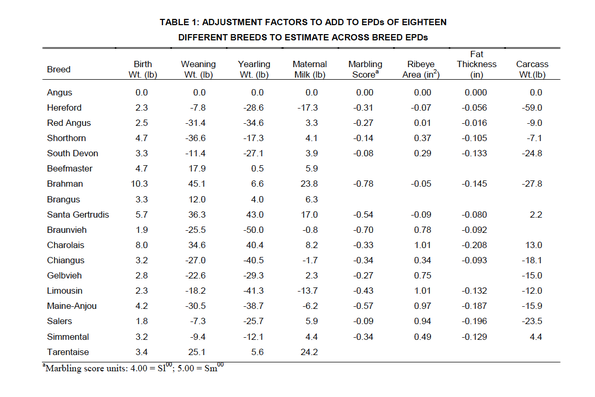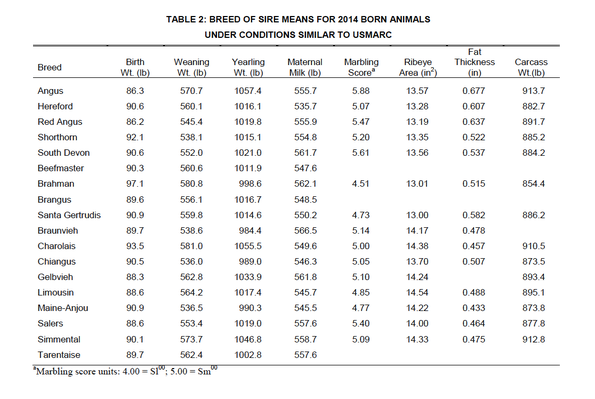Data allows cattle producers to compare bulls of different breeds.
June 22, 2016

Since 1993, geneticists at the U.S. Meat Animal Research Center in Clay Center, Neb. have calculated across-breed adjustment factors for EPDs indicating growth traits and maternal milk, allowing commercial cow-calf producers to compare bulls of different breeds on a level performance basis. Adjustment factors for carcass traits have been calculated since 2009 and carcass weight was added in 2015.
For 2016, USMARC geneticists have released a comprehensive table of adjustment factors for 18 different breeds, giving cattle producers an excellence reference source when comparing bulls (Table 1).
To be included, breeds must have carcass data in the USMARC database and report their carcass EPDs on an actual carcass basis using an age-adjusted endpoint. Bulls of different breeds can be compared on the same EPD scale by adding the appropriate adjustment factor to the EPDs produced in the most recent genetic evaluations for each of the 18 breeds.
The AB-EPDs are most useful to commercial producers purchasing bulls of more than one breed to use in cross-breeding programs. For example, in terminal crossbreeding systems, AB-EPDs can be used to identify bulls in different breeds with high growth potential or favorable carcass characteristics.

Suppose a Charolais bull has a weaning weight EPD of + 25.0 pounds and a Hereford bull has a weaning weight EPD of + 55.0 pounds. The across-breed adjustment factors for weaning weight are 34.6 pounds for Charolais and -7.8 pounds for Hereford. The AB-EPD is
25.0 pounds + 34.6 pounds = 59.6 pounds for the Charolais bull and 55.0 – 7.8 = 47.2 pounds for the Hereford bull. The expected weaning weight difference when both are mated to cows of another breed (e.g., Angus) would be 59.6 pounds – 47.2 pounds = 12.4 pounds.
Most breed associations publish EPDs at least on an annual basis. These EPDs predict differences expected in performance of future progeny of two or more bulls within the same breed for traits including birth weight, weaning weight, yearling weight, and maternal milking ability (as reflected in progeny weaning weights).
Normally, the EPDs of bulls from different breeds cannot be compared because most breed associations compute their EPDs in separate analyses and each breed has a different base point. The across-breed adjustment factors allow producers to compare the EPDs for animals from different breeds for these traits; these factors reflect both the current breed difference (for animals born in 2014) and differences in the breed base point. They should only be used with EPDs current as of June 2016 because of potential changes in EPD calculations from year to year.

BEEF Seedstock 100 List
Looking for a new seedstock provider? Use our UPDATED Seedstock 100 listing to find the largest bull sellers in the U.S. Browse the list here.
It is important to note that the factors in Table 1 do not represent a direct comparison among the different breeds because of base differences between the breeds. They should only be used to compare the EPDs (AB-EPDs) of animals in different breeds. To reduce confusion, breed of sire statistical means (i.e., when sires from two different breeds are mated to cows of a third, unrelated breed) for animals born in 2014 under conditions similar to USMARC are presented in Table 2.

The adjustment factors in Table 1 were updated using EPDs from the most recent national cattle evaluations conducted by each of the 18 breed associations, current as of March 2016. The breed differences used to calculate the factors are based on comparisons of progeny of sires from each of these breeds in the Germplasm Evaluation Program at USMARC in Clay Center, Neb.
These analyses were conducted by USMARC geneticists Larry Kuehn and Mark Thallman. Contact Kuehn at [email protected] or call 402-762-4352; contact Thallman at [email protected] or call 402-762-4261.
You might also like:
9 new pickups for the ranch in 2016
Use cow-pie-ology to monitor your herds nutritional status
70 photos of hardworking beef producers
5 must-do steps for fly control on cattle
Photo Tour: World's largest vertically integrated cattle operation
When is the best time to wean? It might be younger than you think
You won't believe this is the least expensive way to breed cows
You May Also Like



